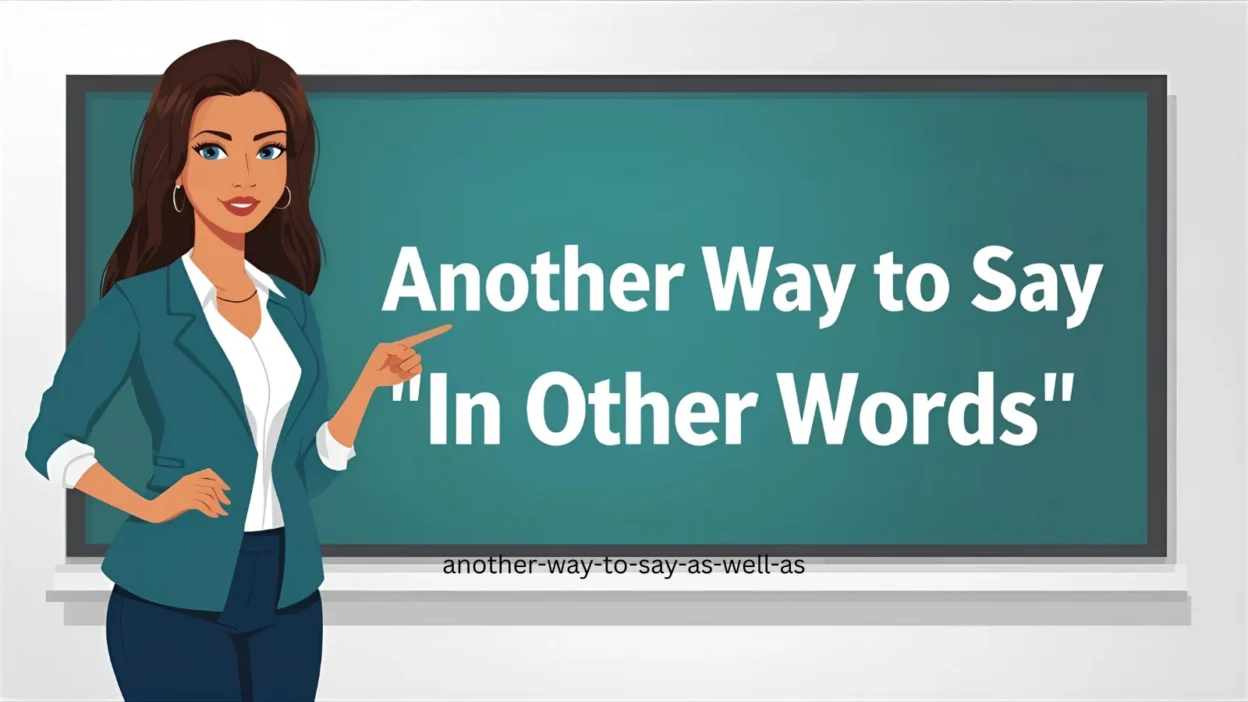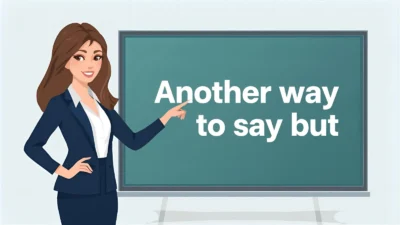The phrase “in other words” is used to rephrase, clarify, or simplify an idea so the listener or reader can better understand it. It’s useful in both formal and informal contexts, but repeating it too often may feel redundant. Luckily, there are many alternatives that can help you sound more professional, conversational, or creative depending on the situation.
In this article, you’ll discover 50 different ways to say “in other words” with meanings, explanations, examples, best use cases, and tone descriptions.
1. To Put It Simply
Meaning: Make something easier to understand.
Explanation: Breaks down a complex idea into simpler terms.
Example: “To put it simply, the project needs more time.”
Best Use: Explaining complicated topics.
Tone: Clear, approachable.
2. That Is to Say
Meaning: Restating for clarity.
Explanation: Slightly formal, common in writing.
Example: “He’s an autodidact—that is to say, he’s self-taught.”
Best Use: Academic or formal contexts.
Tone: Professional, precise.
3. To Clarify
Meaning: Explain in a clearer way.
Explanation: Emphasizes precision and understanding.
Example: “To clarify, we’re meeting at 10 a.m., not 11.”
Best Use: Professional, instructions.
Tone: Polite, clear.
4. Put Another Way
Meaning: Restating from a different angle.
Explanation: Flexible in both speech and writing.
Example: “Put another way, we need more resources.”
Best Use: Work and academic contexts.
Tone: Neutral, professional.
5. To Put It Differently
Meaning: Express something in another form.
Explanation: Good for avoiding repetition.
Example: “To put it differently, the risks outweigh the benefits.”
Best Use: Reports, presentations.
Tone: Formal, professional.
6. In Simpler Terms
Meaning: Make something less complex.
Explanation: Great for explaining technical topics.
Example: “In simpler terms, the app just makes your life easier.”
Best Use: Teaching, casual conversations.
Tone: Friendly, clear.
7. Simply Put
Meaning: Summarize or simplify.
Explanation: Short, concise alternative.
Example: “Simply put, we’re not ready yet.”
Best Use: Everyday speech, business talks.
Tone: Direct, casual.
8. Namely
Meaning: Provide a specific explanation.
Explanation: Useful when giving details.
Example: “He specializes in modern art, namely abstract expressionism.”
Best Use: Academic, professional writing.
Tone: Formal, specific.
9. That Means
Meaning: Explain the implication of something.
Explanation: Natural in conversation.
Example: “The flight is delayed—that means we’ll miss the connection.”
Best Use: Casual or professional speech.
Tone: Neutral.
10. What I Mean Is
Meaning: Clarify a previous statement.
Explanation: More conversational and personal.
Example: “What I mean is, we should try a different approach.”
Best Use: Informal, conversations.
Tone: Casual, approachable.
11. To Be Clear
Meaning: Ensure understanding.
Explanation: Often used to avoid confusion.
Example: “To be clear, this policy starts next month.”
Best Use: Work communication.
Tone: Polite, direct.
12. Or Rather
Meaning: Correct or refine a statement.
Explanation: Often used to adjust wording.
Example: “We’ll meet on Friday—or rather, Saturday morning.”
Best Use: Conversations, writing.
Tone: Neutral, precise.
13. In Layman’s Terms
Meaning: Explain in simple, everyday language.
Explanation: Often used for technical topics.
Example: “In layman’s terms, the device is like a tiny computer.”
Best Use: Teaching, non-technical audiences.
Tone: Clear, relatable.
14. To Put It Briefly
Meaning: Summarize in fewer words.
Explanation: Great for concise communication.
Example: “To put it briefly, the deal didn’t go through.”
Best Use: Reports, quick explanations.
Tone: Professional, concise.
15. Better Put
Meaning: Express something more effectively.
Explanation: Shows refinement of an idea.
Example: “Better put, we’re facing a serious challenge.”
Best Use: Professional discussions.
Tone: Polished, professional.
16. Let Me Rephrase
Meaning: Restate to clarify meaning.
Explanation: Helps avoid miscommunication.
Example: “Let me rephrase: we need more data before deciding.”
Best Use: Conversations, meetings.
Tone: Neutral, polite.
17. Otherwise Said
Meaning: Expressed differently.
Explanation: Similar to “in other words,” but less common.
Example: “Otherwise said, teamwork is essential for success.”
Best Use: Writing, formal contexts.
Tone: Professional.
18. To Put It Another Way
Meaning: Restating an idea.
Explanation: Smooth and formal.
Example: “To put it another way, the budget won’t cover this expense.”
Best Use: Presentations, reports.
Tone: Neutral, professional.
19. Expressed Differently
Meaning: Restate with variation.
Explanation: Suitable for formal or academic tone.
Example: “Expressed differently, the data shows a clear trend.”
Best Use: Academic writing.
Tone: Formal.
20. Which Is to Say
Meaning: Add clarification.
Explanation: Sounds natural in writing.
Example: “She’s a polyglot, which is to say she speaks many languages.”
Best Use: Writing, formal or creative.
Tone: Semi-formal, explanatory.
21. Another Way of Saying This
Meaning: Restate an idea.
Explanation: Simple and flexible.
Example: “Another way of saying this is that we need more time.”
Best Use: Presentations, teaching.
Tone: Neutral.
22. To Put It Clearly
Meaning: State more directly.
Explanation: Focuses on better understanding.
Example: “To put it clearly, this policy benefits employees.”
Best Use: Workplace, presentations.
Tone: Professional.
23. Plainly Speaking
Meaning: Speak in simple, direct terms.
Explanation: Less formal, conversational.
Example: “Plainly speaking, we can’t afford it.”
Best Use: Informal conversations.
Tone: Casual, direct.
24. Succinctly Put
Meaning: Explain concisely.
Explanation: Works well in professional writing.
Example: “Succinctly put, the risks are too high.”
Best Use: Reports, business writing.
Tone: Formal, concise.
25. Simply Stated
Meaning: Summarize directly.
Explanation: Very close to “in other words.”
Example: “Simply stated, we’re not ready yet.”
Best Use: Formal or semi-formal.
Tone: Professional, clear.
Conclusion
The phrase “in other words” is highly versatile, but using alternatives can make your communication sound fresher and better suited to your audience. For formal writing, try “that is to say,” “succinctly put,” or “expressed differently.” For casual speech, options like “to put it simply,” “what I mean is,” or “plainly speaking” work perfectly. By choosing the right variation, you ensure your message is both clear and engaging.



